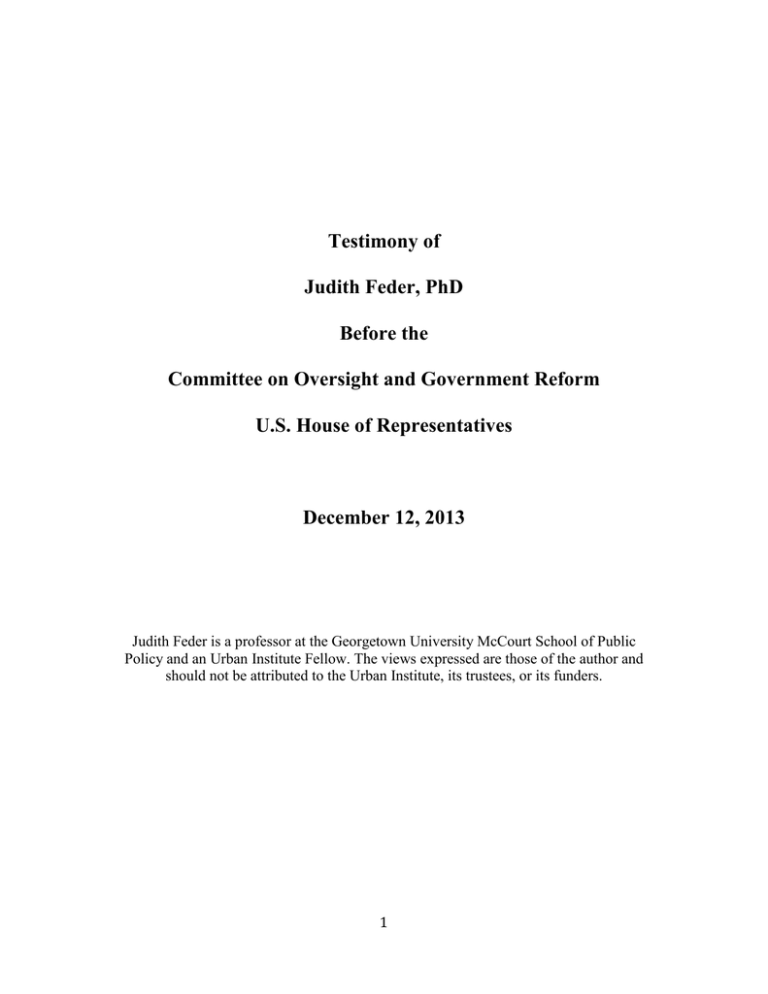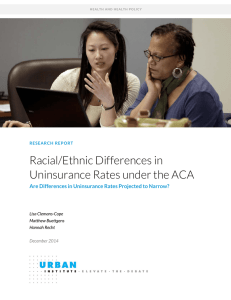Testimony of Judith Feder, PhD Before the Committee on Oversight and Government Reform
advertisement

Testimony of Judith Feder, PhD Before the Committee on Oversight and Government Reform U.S. House of Representatives December 12, 2013 Judith Feder is a professor at the Georgetown University McCourt School of Public Policy and an Urban Institute Fellow. The views expressed are those of the author and should not be attributed to the Urban Institute, its trustees, or its funders. 1 Chairman Issa, Ranking Member Cummings and members of the committee, I welcome the opportunity to speak with you today about the Affordable Care Act. I have spent my career at Georgetown University and elsewhere examining the challenges facing our nation’s health care system and exploring ways to improve it. Over that time, I have watched the number of Americans without health insurance rise to 50 million people, even as Americans who have health insurance spend more and more to hold onto it. At long last, the Affordable Care Act enables us to assure Americans access to affordable health care. We have a simple choice: effectively implement the law or resign ourselves to the unacceptable status quo. My own research has contributed to a substantial body of literature demonstrating that Americans without health insurance get less care, get it later in the course of illness, and are more likely to die than Americans without it. 1 And to the extent they get care, it is paid for by those of us who have health insurance—in our insurance premiums and through our local, state and federal taxes. Who are the uninsured? They are mostly workers, or in families of workers, who are not offered coverage through their jobs, the way most of us are. Pre-ACA they had few options to protect themselves. Coverage in the nongroup or individual market simply does not work to protect people when they get sick. 2 Individual insurance denies 1 Institute of Medicine, “America’s Uninsured Crisis,” Washington, D.C., National Academy Press, 2009 http://books.nap.edu/openbook.php?record_id=12511 2 Statement of Sabrina Corlette, Georgetown University Health Policy Institute to the Subcommittee on Health, Committee on Energy and Commerce, U.S. House of Representatives, November 14, 2013 http://docs.house.gov/meetings/IF/IF14/20131114/101481/HHRG-113-IF14-Wstate-CorletteS20131114.pdf 2 coverage or requires exorbitant premiums for people with pre-existing conditions, limits covered services (often excluding prescription drugs, for example), and limits total dollars in benefits, leaving people who think they are insured at huge financial risk. People who want to keep that insurance typically find that insurers make it impossible— raising premiums or imposing other barriers to limit the risk that the insurer will have to pay claims. Although Medicaid provides an invaluable safety net for people who are eligible, many poor and modest wage workers also lack access to its protections. 3 Medicaid’s health insurance focuses overwhelmingly on low income children, pregnant women, and people with disabilities. Except in a few states with waivers from federal law, Medicaid excludes coverage of adults who are not parents of dependent children—no matter how poor they are. The very same low and modest earners who cannot get coverage through their jobs, then, cannot get public protection. It is these giant holes in our health financing structure that the ACA aims to fill. To guarantee available coverage in the individual market, the ACA requires insurers to accept everyone; it prohibits rate variation based on health status and gender, and it limits rate variation based on age. To guarantee adequate coverage, the ACA requires coverage of “minimum essential health benefits” defined to cover the range of services health professionals typically provide; and prohibits dollar caps on annual and lifetime benefits. To prevent adverse selection (that is, enabling people to wait until they get sick to enroll), 3 Kaiser Family Foundation, “Medicaid—A Primer,” March 1, 2013. http://kff.org/medicaid/issuebrief/medicaid-a-primer/ 3 the ACA accompanies these requirements on insurers are with requirements on individuals—to purchase coverage or pay a penalty. And to make that requirement feasible and coverage affordable, the ACA provides tax credits and other protection to limit people’s premiums and cost-sharing as a share of income. These policies together make it possible to transform what is now offered as individual insurance into what insurance is supposed to be—available, adequate and affordable. The ACA addresses the holes in Medicaid by expanding its eligibility to people with incomes below 138 percent of the federal poverty level (about $15,900 for an individual and $32,500 for a family of four), regardless of their family status. Financing for that coverage expansion is fully federal until 2017 and gradually declines to 90 percent in 2020 and subsequent years. The Supreme Court ruled that states have the choice of whether or not to participate in that expansion. But analysis shows that the expansion will make states financially better off by reducing the burden of uncompensated care, while contributing to overall health of state economies. 4 Indeed, because taxpayers in all states contribute to financing for the ACA, citizens in states that choose not to participate in Medicaid actually pay for benefits in other states—without reaping any of the benefits in additional federal funds. 5 4 John Holahan et al., “The Cost and Coverage Implications of Medicaid Expansion,” Kaiser Family Foundation, November 2012 http://kaiserfamilyfoundation.files.wordpress.com/2013/01/8384_es.pdf 5 Sherry Glied and Stephanie Ma, “How States Stand to Lose or Gain Federal Funds By Opting In or Out of the Federal Expansion,” The Commonwealth Fund, December 2013 http://www.commonwealthfund.org/~/media/Files/Publications/Issue%20Brief/2013/Dec/1718_Glied_how _states_stand_gain_lose_Medicaid_expansion_ib_v2.pdf 4 Despite claims to the contrary, the law leaves the employer-sponsored insurance that most of us depend on fundamentally as it is today. Indeed, with a limited affordability exception, workers offered coverage are not eligible for subsidies in the ACA’s new marketplaces, which are explicitly limited to people not offered coverage through their jobs. Except for requirements that children’s coverage extend to age 26, requirements that preventive benefits be available without cost-sharing, and some consumer protections, the benefits and operation of large-employer plans are largely untouched by the law. Analyses by CBO, Rand, and my colleagues at the Urban Institute show that employersponsored health insurance will remain the core of the American health insurance system. 6 Alongside its support for coverage expansion, the ACA has contributed to a remarkable slowdown in health care cost growth. Health care spending per person from 2010-2013 is growing at the lowest annual rate on record for any three-year period, 7 in part a reflection of the ACA’s elimination of Medicare overpayments and promotion of initiatives supporting more efficient, higher-quality, and more patient-centered delivery of health care services. By filling the gaps in our current financing structure and slowing the growth in our health care costs, the ACA has enormous potential to address the flaws in our health care system 6 Linda Blumberg et al., “Why Employers Will Continue to Provide Health Insurance,” The Urban Institute, October 2011 http://www.urban.org/UploadedPDF/412428-The-Impact-of-the-Affordable-CareAct.pdf 7 Executive Office of the President, “Trends in Health Care Cost Growth and the Impact of the Affordable Care Act,” November 2013 http://www.whitehouse.gov/sites/default/files/docs/healthcostreport_final_noembargo_v2.pdf 5 that all of us decry. The biggest barrier I see to realizing the law’s potential is the political resistance to the law’s implementation. Roughly half the states are rejecting the Medicaid expansion that is so clearly in the health and fiscal interest of their citizens; more than half are rejecting the opportunity to design their own insurance marketplaces; and Congress is not providing the federal government adequate resources to perform its responsibilities, as well as to substitute, where it can, for states’ unwillingness to act. States’ resistance to the Medicaid expansion will leave more than 5 million Americans uninsured whom the law could insure—not only burdening the affected families but also the providers and the insured population who will continue to face the challenge of uncompensated care. States’ resistance to creating their own marketplaces along with inadequate support for federal administration may similarly undermine enrollment in private insurance. But through Medicaid and those marketplaces, enrollment is now moving forward. Come January 1, millions of Americans will, for the first time, have access to affordable insurance they can count on when they are sick. Along with the benefits people are already reaping from the ACA—like expansion of coverage to 26-year-olds on their parents’ policies, preventive care services provided without charge, enhancement of prescription drug coverage for Medicare beneficiaries—new coverage through Medicaid and the marketplaces will be delivering on the promise of the Affordable Care Act. The faster we move to deliver on that promise, the better. The ACA creates an enormous opportunity to address flaws we all recognize in our health financing system. It does not 6 fix all the system’s flaws, and its own fixes will need improvement as we go along. All of us should be working together to make the law work. To impede its implementation and return to a world without the ACA—with 50 million people uninsured, insurance markets that deny coverage based on pre-existing conditions, and rapidly escalating costs—is simply unacceptable. 7





